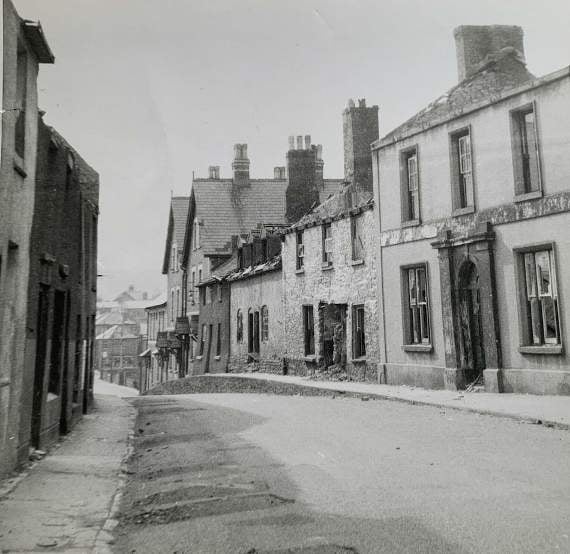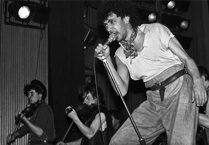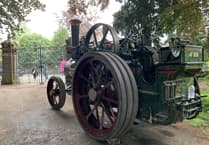IN 1957 civic planners gave the green light to wholesale slum clearances which systematically destroyed much of the old part of Abergavenny and changed it beyond recognition. Nowhere was this more evident than in what used to be the most notorious part of Abergavenny - Tudor Street.
In gung-ho fashion, many fine Elizabethan buildings, and more importantly, people’s homes were bulldozed to make way for the sharp-edged utilitarianism and banal box designs of modernity.
The historic dwellings and public houses in Tudor Street and St John’s Square were replaced with a Police Station, a Magistrates Court, a Job Centre, and a Post Office.
Suffice to say, the unique character of the area had been somewhat diminished, and the community had been broken, scattered, and moved on to purpose-built council homes elsewhere.
Addressing the Abergavenny Borough Council at the time, Alderman V.R. Pugsley reflected on the demolition of Tudor Street, Byfield Lane, St John’s Square, Mill Street, and parts of Flannel Street, Chicken Street, and Nevill Street with the following nugget of town planning wisdom, “It should be remembered that what we do will affect this town for many years to come.”
And indeed it did.
Ironically, until the middle of the 19th century, Tudor Street was where rich merchants and respectable town burgesses lived the life of Riley in enormous houses. Its reputation as Abergavenny’s wealthiest suburb took a hit toward the latter half of the 19th century.
The grand houses were split into tenements and in their former gardens and coach-yards, small cottages were built.
Towards the turn of the 20th century, Tudor Street was described as “a populous working-class district,” and so when it came to knocking it down, the civic planners ruled that "nothing of historical or architectural interest" would be found in such an area.
As the bulldozers moved in and the wrecking crews rubbed their hands, unique 17th-century wall paintings were found hiding beneath years of accumulated wallpaper and paint, as were elaborate fireplaces, elaborately moulded oak mantels and other such historical curiosities.
Unfortunately, most of it was destroyed before it could be recorded for posterity, but some artifacts were salvaged and can now be seen in Abergavenny Museum.
Remembering the slum clearance in the book, “Abergavenny, in the Twentieth Century,” a contributor who shall remain nameless to spare their blushes, writes how the “terrible slums” of Tudor Street desperately needed demolishing for the welfare of their poor inhabitants in a fatalistically poetic fashion.
“Here (Tudor Street) they existed in indescribable poverty and misery. Owing to the narrowness of the alley, one side was always in the shadow of the sun. Their only joy in life was the thought of death to remove them from the squalor.”
Those born and bred in the are would no doubt beg to differ. Former Mayor of Abergavenny Norma Watkins was one such person.
In an oral history interview with the team behind the Forgotten Abergavenny project, Norma recalls her grandmother was “spitting feathers” at being forced from her home, in the “roughest, toughest, street in town,” but where the “sense of community was absolutely unbelievable.”
Norma remembers, “You had to move. You had no choice. Because in those days there wasn’t any real notion that you could take them to Court or stop them doing any of this stuff. Some houses were owned by them: it was a compulsory purchase and you had no choice. You were out. They condemned the houses, wholesale. They condemned them and said that’s it, they’re not fit to live in, you’ve got to go.
“This is how they broke the community up. They didn’t move, say, a block of houses altogether and keep the community together; they just moved them and scattered them.
“I think they wanted to break Tudor Street apart.”
As you can see from the pictures if the wrecking ball hadn’t swung and the bulldozers hadn’t flattened, and preservation, as opposed to progress, was the watchword, then Tudor Street would look a lot different today, but as in all things you’ve got to make the most of a bad hand and Abergavenny will continue to play on and see what the dealer has up his sleeve next. The important thing is to stay in the game!
All of the featured pictures of old Abergavenny are from the Albert Lyons collection. Mr. Lyons was a well-known character around town and played a massively important role in documenting Abergavenny through the camera lens during a time of great social and physical upheaval for the area.
The founder member of Abergavenny Camera club captured for posterity the old Tudor Street and Byfield Lane areas, and as well as bring a talented lensman in his own right, Mr. Lyons was a keen collector of old photographs and postcards of Abergavenny and published two hugely popular books of pictorial histories on the town.
Born in Princes Street, Albert’s father and grandfather were both keepers on the Coldbrook Estate for the Herbert family.
Albert was a pupil at Victoria Street’s ‘British School’ before finding work on the railways. After serving in the Second World War he returned to the railways until its closure in 1958 and then worked at Pen-y-Fal as a porter.
Albert passed away in Nevill Hall Hospital, aged, 75 but left a photographic legacy that cannot be underestimated.
Local historian Chris Barber has been the custodian of Albert Lyons’ photographs for a number of years but he has recently kindly entrusted the Chronicle with the safekeeping of a collection that he feels could benefit from being showcased to a new generation.
With this in mind, the Chronicle will be featuring a selection of Albert’s pictures in the weeks and months to come, because now more than ever, the past should always inform the present.





Comments
This article has no comments yet. Be the first to leave a comment.